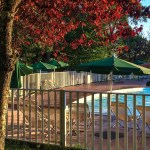When it’s time to install a new fence, there are a lot of decisions to make. However, the one that’s probably at the top of the list is which material to choose. No other single factor will have as much impact on the price, quality and lifespan of your new fence, so it’s worth taking some time to understand the options available. Choosing the right material always means striking a balance between different needs. The most durable material is usually not the most beautiful, and vice versa. Let’s take a look at one of the best all-around materials available today: vinyl.

So What Is Vinyl Fencing?
Strictly speaking, “vinyl” is polyvinyl chloride, a strong, lightweight type of plastic discovered in the 1920s. Over the past century, the popularity of vinyl has grown, and it is now used in everything from food packaging to automobile parts. When used in fencing, PVC is combined with other compounds such as titanium dioxide, which gives it excellent UV resistance. This formulation results in a strong, flexible compound that can withstand sunlight, temperature extremes, high winds and direct impacts with an amazing degree of strength. While some vinyl fencing systems use metal brackets for the final assembly, others are designed as tongue-and-groove systems so that everything is made of the same light, strong materials. Far from being an ecological disaster, PVC is extremely recyclable, and it requires less energy to manufacture than most other types of plastic. Combined with its unusually long life cycle and the fact that 99% of material used in manufacturing ends up as usable product, this means that PVC is one of the least ecologically impactful materials used in modern manufacturing.
What Does Vinyl Fencing Look Like?
While some people maintain that a wood fence is more attractive than vinyl, the truth is that beauty is in the eye of the beholder. If a vinyl fence looks out of place, it’s most likely because it’s too bright, clean and straight compared to a natural-looking background. Fortunately, vinyl fence is available in a range of colors and styles, and getting a vinyl fence to look great on your property is a simple matter of choosing a look that compliments the rest of your environment. Many different types of vinyl fence are available, from a standard post-and-rail style to an elegant Lexington-style privacy fence. Furthermore, a Vinyl fence can be textured like wood or even stone, and posts can be fitted with decorative caps for a very attractive look. Since vinyl is available in a large range of colors, these different styles and textures add up to a nearly infinite variety of looks which can be achieved.
Is Vinyl Easy to Maintain?
If you’ve ever had a wood fence, you already know more than you ever wanted to know about fence maintenance. The truth is that wood fences look great when they’re brand new, but they require a lot of work to keep them that way. In fact, even if you sand and stain a wood fence every two years as recommended, it’s still going to fade, warp and split over time. By comparison, a vinyl fence just needs to be washed about once a year. What’s more, you can usually get the job done with a garden hose and a wash mitt. Sounds a lot easier, doesn’t it? If there is a need to repair any damage, it’s usually a simple matter of buying a single replacement piece and snapping it into place. You generally don’t even need any tools for the job.
Does Vinyl Stand Up to Weather?
People living in all kinds of climates will swear by their vinyl fencing. This is because PVC is generally very temperature-resistant. While of course it does expand and contract slightly as the seasons change, it’s designed to fit together no matter what. Unlike wood, which splits and cracks as it heats and cools over the years, vinyl just returns to its old size, none the worse for wear. Water poses a big problem for wood fencing, whether in the form of rain, snow, or ground moisture, causing warping and rotting. However, water literally rolls off a vinyl fence without affecting it in any way. Sunlight fades and warps wood over time, but because of the titanium oxide added to the PVC, sunlight has no effect on a vinyl fence – it’s got sunscreen built in! In fact, even fire can barely harm a vinyl fence; the ignition temperature of PVC is around 900 degrees, and it’s classified as a “self-extinguishing” material. Remove the source of heat, and the vinyl stops burning. In other words, while no fence is totally indestructible, a vinyl fence comes awfully close
How Long Does a Vinyl Fence Last?.
Now we come to the bottom line: how many years can you expect to get out of a high-quality vinyl fence? Most sources say that you can expect to get 20 to 30 years out of a well-maintained fance. The truth, however, is that vinyl fences have really only been popular for about that long, so it’s hard to say. Some of those early vinyl fences are still going strong, and modern vinyl fences are being made better and stronger than the ones from the 1980s. No one really knows how long today’s vinyl fences will last, but we do know that it will be at least a couple of decades, and possibly a lot longer. By comparison, a wood fence will only last anywhere from 7 to 15 years at the most, depending on the type of wood used. Furthermore, that assumes you’re re-staining and repairing them every couple of years. Remember, all you have to do to maintain a vinyl fence is run a hose over it once a year! Compared to wood, vinyl is a superb choice for a durable, long-lasting fence that won’t warp, discolor or break over time. Because it’s more economical than metal and can’t rust, it really does strike the best balance between value and durability when compared to other fencing materials.
Find Out more!
If you’re ready to learn more about this innovative and useful material, and to find out what a vinyl fence could do for your property, contact us today. At Clarksville Fencing, we have decades of experience and a wide variety of styles for you to choose from, and we’d be happy to help find the right fence for you – now and for decades to come.







